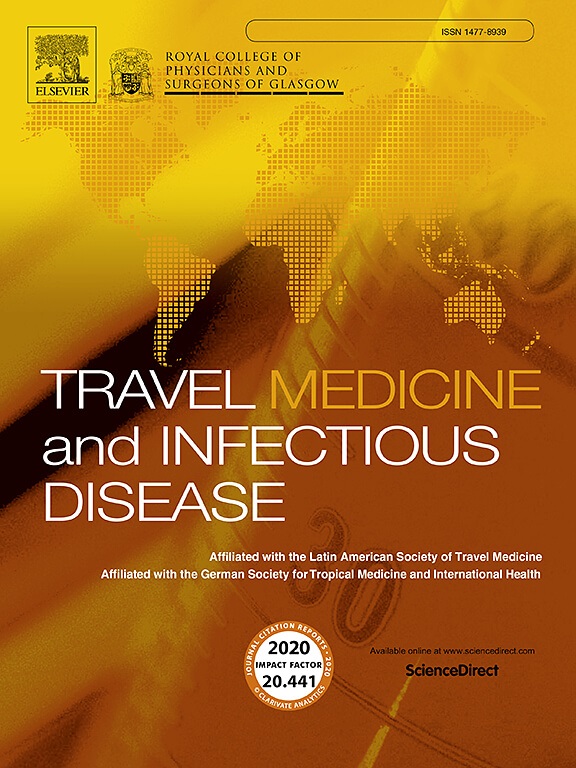预测游轮上的诺如病毒病例,以支持船上的疫情管理。
IF 4.7
3区 医学
Q1 INFECTIOUS DISEASES
引用次数: 0
摘要
背景:诺如病毒在游轮上的爆发是对游轮业的重大威胁。数学模型有可能利用船上常规收集的综合征监测数据来深入了解疫情演变。方法:利用2011-2013年7次诺如病毒暴发的历史数据,共359例诊断病例,实时评估自动化预测的性能。我们使用对数评分(log)、排名概率评分(RPS)和95%覆盖率,比较了一组备选模型在三个端点(症状发作时间的病例数、诊断日期的病例数和巡航结束前的总病例数)上的性能。结果:我们发现,同时包含超扩散和病例隔离效应的模型具有最佳的预测性能。在大多数情况下,该模型的得分高于假设发病率恒定的基线模型;当使用日志评估时,这种情况发生在59-70%的数据点上,使用RPS评估时发生在53-57%的数据点上(取决于所考虑的端点)。最好的模型在所有端点上的覆盖率也最高。根据log和RPS的数据,其附加值在更长的预测范围内尤为明显,高达78%的数据点的性能得到了改善。结论:综合诺如病毒传播关键机制的简单数学模型有助于预测船上病例数。这些知识可以在综合征监测系统中自动化,以支持疫情管理的决策。本文章由计算机程序翻译,如有差异,请以英文原文为准。
Forecasting norovirus cases on cruise ships to support outbreak management on board
Background
Norovirus outbreaks on cruise ships are a significant threat to the cruising industry. Mathematical models have the potential to leverage routinely collected syndromic surveillance data on board to provide insight into outbreak evolution.
Methods
We used historical data from seven norovirus outbreaks occurred in 2011–2013, totalling 359 diagnosed cases, to assess the performance of automated forecasts in real-time. We compared the performance of a set of alternative models on three endpoints (the number of cases by symptom onset time, by diagnosis date, and the total number of cases until the end of the cruise), using the logarithmic score (logS), the ranked probability score (RPS), and the 95 % coverage.
Results
We found that the best forecasting performance was given by a model that includes both superspreading and the effect of case isolation. This model had in most cases a better score than that of a baseline model assuming constant incidence; this happened in 59–70 % of data points when assessed using the logS and 53–57 % with the RPS (depending on the considered endpoint). The best model also had the highest coverage over all endpoints. Its added value was especially evident for longer forecasting horizons, with an improvement in performance for up to 78 % of data points, both according to the logS and the RPS.
Conclusions
Simple mathematical models integrating key mechanisms of norovirus transmission can help predict the number of cases on board. This knowledge can be automatized in syndromic surveillance systems to support decision making for the management of outbreaks.
求助全文
通过发布文献求助,成功后即可免费获取论文全文。
去求助
来源期刊

Travel Medicine and Infectious Disease
PUBLIC, ENVIRONMENTAL & OCCUPATIONAL HEALTH-INFECTIOUS DISEASES
CiteScore
19.40
自引率
1.70%
发文量
211
审稿时长
49 days
期刊介绍:
Travel Medicine and Infectious Disease
Publication Scope:
Publishes original papers, reviews, and consensus papers
Primary theme: infectious disease in the context of travel medicine
Focus Areas:
Epidemiology and surveillance of travel-related illness
Prevention and treatment of travel-associated infections
Malaria prevention and treatment
Travellers' diarrhoea
Infections associated with mass gatherings
Migration-related infections
Vaccines and vaccine-preventable disease
Global policy/regulations for disease prevention and control
Practical clinical issues for travel and tropical medicine practitioners
Coverage:
Addresses areas of controversy and debate in travel medicine
Aims to inform guidelines and policy pertinent to travel medicine and the prevention of infectious disease
Publication Features:
Offers a fast peer-review process
Provides early online publication of accepted manuscripts
Aims to publish cutting-edge papers
 求助内容:
求助内容: 应助结果提醒方式:
应助结果提醒方式:


